一.基本理论
Android六大基本布局分别是:线性布局LinearLayout、表格布局TableLayout、相对布局RelativeLayout、
层布局FrameLayout、绝对布局AbsoluteLayout、网格布局GridLayout。
其中,表格布局是线性布局的子类。网格布局是android 4.0后新增的布局。
在手机程序设计中,绝对布局基本上不用,用得相对较多的是线性布局和相对布局。
学习基本布局要理解两个比较基础概念的图:
(一)Android布局管理器的类图
上面这个类图只是说了六大基本布局的关系,其实ViewGroup还有其他一些布局管理器。
这里要理解一点就是布局也是布局管理器,因为布局里面还可以添加布局。
(二)Android布局的XML关系图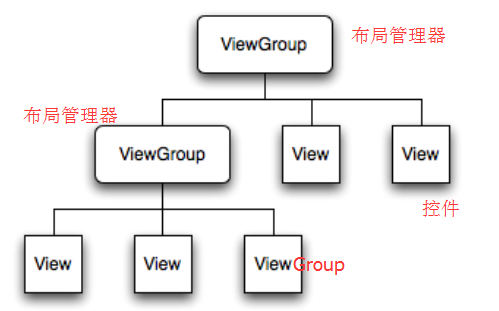
布局管理器里面既可以添加多个布局管理器又可以添加多个控件,而控件里面不能在添加布局或控件了。
二.各个布局的使用
(一)线性布局
线性布局在开发中使用最多,具有垂直方向与水平方向的布局方式,通过设置属性“android:orientation”控制方向,属性值垂直(vertical)和水平(horizontal),默认水平方向。
android:gravity:内部控件对齐方式,常用属性值有center、center_vertical、center_horizontal、top、bottom、left、right等。
这个属性在布局组件RelativeLayout、TableLayout中也有使用,FrameLayout、AbsoluteLayout则没有这个属性。
center:居中显示,这里并不是表示显示在LinearLayout的中心,当LinearLayout线性方向为垂直方向时,center表示水平居中,但是并不能垂直居中,此时等同于center_horizontal的作用;同样当线性方向为水平方向时,center表示垂直居中,等同于center_vertical。
top、bottom、left、right顾名思义为内部控件居顶、低、左、右布局。
这里要与android:layout_gravity区分开,layout_gravity是用来设置自身相对于父元素的布局。
android:layout_weight:权重,用来分配当前控件在剩余空间的大小。
使用权重一般要把分配该权重方向的长度设置为零,比如在水平方向分配权重,就把width设置为零。
示例:多功能计算机的设计
<LinearLayout xmlns:android="http://schemas.android.com/apk/res/android"
xmlns:tools="http://schemas.android.com/tools"
android:layout_width="match_parent"
android:layout_height="match_parent"
android:orientation="vertical" >
<RelativeLayout
android:layout_width="match_parent"
android:layout_height="80dp"
android:background="#1000" >
<TextView
android:layout_width="wrap_content"
android:layout_height="wrap_content"
android:layout_alignParentBottom="true"
android:layout_alignParentRight="true"
android:padding="20dp"
android:text="0"
android:textSize="30sp" />
</RelativeLayout>
<LinearLayout
android:layout_width="match_parent"
android:layout_height="match_parent"
android:orientation="horizontal" >
<LinearLayout
android:layout_width="0dp"
android:layout_height="match_parent"
android:layout_weight="2"
android:orientation="vertical" >
<LinearLayout
android:layout_width="match_parent"
android:layout_height="0dp"
android:layout_weight="5"
android:orientation="horizontal" >
<LinearLayout
android:layout_width="0dp"
android:layout_height="match_parent"
android:layout_weight="1"
android:orientation="vertical" >
<Button
android:layout_width="match_parent"
android:layout_height="0dp"
android:layout_weight="1"
android:text="MC" />
<Button
android:layout_width="match_parent"
android:layout_height="0dp"
android:layout_weight="1"
android:text="←" />
<Button
android:layout_width="match_parent"
android:layout_height="0dp"
android:layout_weight="1"
android:text="7" />
<Button
android:layout_width="match_parent"
android:layout_height="0dp"
android:layout_weight="1"
android:text="4" />
<Button
android:layout_width="match_parent"
android:layout_height="0dp"
android:layout_weight="1"
android:text="1" />
</LinearLayout>
<LinearLayout
android:layout_width="0dp"
android:layout_height="match_parent"
android:layout_weight="1"
android:orientation="vertical" >
<Button
android:layout_width="match_parent"
android:layout_height="0dp"
android:layout_weight="1"
android:text="MR" />
<Button
android:layout_width="match_parent"
android:layout_height="0dp"
android:layout_weight="1"
android:text="CE" />
<Button
android:layout_width="match_parent"
android:layout_height="0dp"
android:layout_weight="1"
android:text="8" />
<Button
android:layout_width="match_parent"
android:layout_height="0dp"
android:layout_weight="1"
android:text="5" />
<Button
android:layout_width="match_parent"
android:layout_height="0dp"
android:layout_weight="1"
android:text="2" />
</LinearLayout>
</LinearLayout>
<LinearLayout
android:layout_width="match_parent"
android:layout_height="0dp"
android:layout_weight="1" >
<Button
android:layout_width="match_parent"
android:layout_height="match_parent"
android:text="0" />
</LinearLayout>
</LinearLayout>
<LinearLayout
android:layout_width="0dp"
android:layout_height="match_parent"
android:layout_weight="1"
android:orientation="vertical" >
<Button
android:layout_width="match_parent"
android:layout_height="0dp"
android:layout_weight="1"
android:text="MS" />
<Button
android:layout_width="match_parent"
android:layout_height="0dp"
android:layout_weight="1"
android:text="C" />
<Button
android:layout_width="match_parent"
android:layout_height="0dp"
android:layout_weight="1"
android:text="9" />
<Button
android:layout_width="match_parent"
android:layout_height="0dp"
android:layout_weight="1"
android:text="6" />
<Button
android:layout_width="match_parent"
android:layout_height="0dp"
android:layout_weight="1"
android:text="3" />
<Button
android:layout_width="match_parent"
android:layout_height="0dp"
android:layout_weight="1"
android:text="." />
</LinearLayout>
<LinearLayout
android:layout_width="0dp"
android:layout_height="match_parent"
android:layout_weight="1"
android:orientation="vertical" >
<Button
android:layout_width="match_parent"
android:layout_height="0dp"
android:layout_weight="1"
android:text="M+" />
<Button
android:layout_width="match_parent"
android:layout_height="0dp"
android:layout_weight="1"
android:text="±" />
<Button
android:layout_width="match_parent"
android:layout_height="0dp"
android:layout_weight="1"
android:text="/" />
<Button
android:layout_width="match_parent"
android:layout_height="0dp"
android:layout_weight="1"
android:text="*" />
<Button
android:layout_width="match_parent"
android:layout_height="0dp"
android:layout_weight="1"
android:text="-" />
<Button
android:layout_width="match_parent"
android:layout_height="0dp"
android:layout_weight="1"
android:text="+" />
</LinearLayout>
<LinearLayout
android:layout_width="0dp"
android:layout_height="match_parent"
android:layout_weight="1"
android:orientation="vertical" >
<Button
android:layout_width="match_parent"
android:layout_height="0dp"
android:layout_weight="1"
android:text="M-" />
<Button
android:layout_width="match_parent"
android:layout_height="0dp"
android:layout_weight="1"
android:text="√" />
<Button
android:layout_width="match_parent"
android:layout_height="0dp"
android:layout_weight="1"
android:text="%" />
<Button
android:layout_width="match_parent"
android:layout_height="0dp"
android:layout_weight="1"
android:text="1/x" />
<Button
android:layout_width="match_parent"
android:layout_height="0dp"
android:layout_weight="2"
android:text="=" />
</LinearLayout>
</LinearLayout>
</LinearLayout>
运行结果图: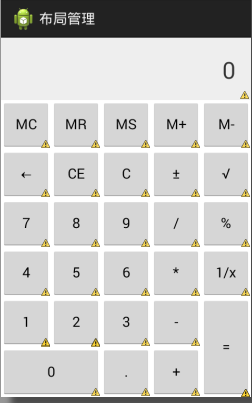
(二)RelativeLayout
相对布局可以让子控件相对于兄弟控件或父控件进行布局,可以设置子控件相对于兄弟控件或父控件进行上下左右对齐。
RelativeLayout能替换一些嵌套视图,当我们用LinearLayout来实现一个简单的布局但又使用了过多的嵌套时,就可以考虑使用RelativeLayout重新布局。
相对布局就是一定要加Id才能管理。
RelativeLayout中子控件常用属性:
1、相对于父控件,例如:android:layout_alignParentTop=“true”
android:layout_alignParentTop 控件的顶部与父控件的顶部对齐;
android:layout_alignParentBottom 控件的底部与父控件的底部对齐;
android:layout_alignParentLeft 控件的左部与父控件的左部对齐;
android:layout_alignParentRight 控件的右部与父控件的右部对齐;
2、相对给定Id控件,例如:android:layout_above=“@id/**”
android:layout_above 控件的底部置于给定ID的控件之上;
android:layout_below 控件的底部置于给定ID的控件之下;
android:layout_toLeftOf 控件的右边缘与给定ID的控件左边缘对齐;
android:layout_toRightOf 控件的左边缘与给定ID的控件右边缘对齐;
android:layout_alignBaseline 控件的baseline与给定ID的baseline对齐;
android:layout_alignTop 控件的顶部边缘与给定ID的顶部边缘对齐;
android:layout_alignBottom 控件的底部边缘与给定ID的底部边缘对齐;
android:layout_alignLeft 控件的左边缘与给定ID的左边缘对齐;
android:layout_alignRight 控件的右边缘与给定ID的右边缘对齐;
3、居中,例如:android:layout_centerInParent=“true”
android:layout_centerHorizontal 水平居中;
android:layout_centerVertical 垂直居中;
android:layout_centerInParent 父控件的中央;
使用示例:
<RelativeLayout xmlns:android="http://schemas.android.com/apk/res/android"
xmlns:tools="http://schemas.android.com/tools"
android:layout_width="match_parent"
android:layout_height="match_parent"
android:paddingBottom="@dimen/activity_vertical_margin"
android:paddingLeft="@dimen/activity_horizontal_margin"
android:paddingRight="@dimen/activity_horizontal_margin"
android:paddingTop="@dimen/activity_vertical_margin"
tools:context="com.xykj.layout.MainActivity" >
<TextView
android:id="@+id/main_tv_title"
android:layout_width="match_parent"
android:layout_height="wrap_content"
android:background="#55ff0000"
android:gravity="center"
android:text="相对布局的使用" />
<!--
android:layout_alignParentBottom="true"位于父框架的底部
android:layout_centerHorizontal="true"在父框架中水平居中
android:layout_centerVertical="true"在父框架中垂直居中
这两个要区分,一个是边界对齐,一个是位于哪个方位
android:layout_below="@+id/main_tv_title"位于对应文件的下边
android:layout_alignRight="@+id/main_tv_title"和对应文件右对齐 -->
<TextView
android:id="@+id/main_tv_title2"
android:layout_width="wrap_content"
android:layout_height="wrap_content"
android:layout_alignRight="@+id/main_tv_title"
android:layout_below="@+id/main_tv_title"
android:background="#5500ff00"
android:text="二级标题" />
<TextView
android:id="@+id/main_tv_center"
android:layout_width="wrap_content"
android:layout_height="wrap_content"
android:layout_centerInParent="true"
android:text="中间"
android:textSize="22sp"
android:layout_margin="30dp" />
<TextView
android:id="@+id/main_tv_up"
android:layout_width="wrap_content"
android:layout_height="wrap_content"
android:layout_above="@id/main_tv_center"
android:layout_alignRight="@id/main_tv_center"
android:text="上面"
android:textSize="22sp" />
<TextView
android:id="@+id/main_tv_dowm"
android:layout_width="wrap_content"
android:layout_height="wrap_content"
android:layout_alignRight="@id/main_tv_center"
android:layout_below="@id/main_tv_center"
android:text="下面"
android:textSize="22sp" />
<TextView
android:id="@+id/main_tv_left"
android:layout_width="wrap_content"
android:layout_height="wrap_content"
android:layout_toLeftOf="@id/main_tv_center"
android:text="左边"
android:layout_alignTop="@id/main_tv_center"
android:textSize="22sp" />
<TextView
android:id="@+id/main_tv_right"
android:layout_width="wrap_content"
android:layout_height="wrap_content"
android:layout_toRightOf="@id/main_tv_center"
android:layout_alignTop="@id/main_tv_center"
android:text="上面"
android:textSize="22sp" />
</RelativeLayout>
效果图:
(三)FrameLayout
帧布局或叫层布局,从屏幕左上角按照层次堆叠方式布局,后面的控件覆盖前面的控件。
该布局在开发中设计地图经常用到,因为是按层次方式布局,我们需要实现层面显示的样式时就可以
采用这种布局方式,比如我们要实现一个类似百度地图的布局,我们移动的标志是在一个图层的上面。
在普通功能的软件设计中用得也不多。层布局主要应用就是地图方面。
使用示例:
<?xml version="1.0" encoding="utf-8"?>
<FrameLayout xmlns:android="http://schemas.android.com/apk/res/android"
android:layout_width="match_parent"
android:layout_height="match_parent" >
<TextView
android:layout_width="300dp"
android:layout_height="300dp"
android:background="#f00"
android:layout_gravity="center"
/>
<TextView
android:layout_width="200dp"
android:layout_height="200dp"
android:background="#0f0"
android:layout_gravity="center"
/>
<TextView
android:layout_width="100dp"
android:layout_height="100dp"
android:background="#00f"
android:layout_gravity="center"
/>
<TextView
android:layout_width="50dp"
android:layout_height="50dp"
android:background="#fff"
android:layout_gravity="center"
/>
<TextView
android:layout_width="20dp"
android:layout_height="20dp"
android:background="#000"
android:layout_gravity="center"
/>
</FrameLayout>
效果图: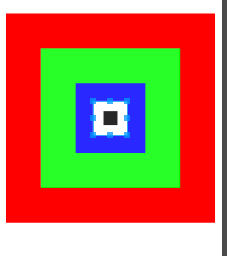
(四)AbsoluteLayout
绝对布局中将所有的子元素通过设置android:layout_x 和 android:layout_y属性,将子元素的坐标位置固定下来,即坐标(android:layout_x, android:layout_y) ,layout_x用来表示横坐标,layout_y用来表示纵坐标。屏幕左上角为坐标(0,0),横向往右为正方,纵向往下为正方。实际应用中,这种布局用的比较少,因为Android终端一般机型比较多,各自的屏幕大小。分辨率等可能都不一样,如果用绝对布局,可能导致在有的终端上显示不全等。
使用示例:
<?xml version="1.0" encoding="utf-8"?>
<AbsoluteLayout xmlns:android="http://schemas.android.com/apk/res/android"
android:layout_width="match_parent"
android:layout_height="match_parent" >
<TextView
android:layout_height="wrap_content"
android:layout_width="wrap_content"
android:layout_x="20dp"
android:layout_y="20dp"
android:text="用户名:"
/>
<EditText
android:layout_height="wrap_content"
android:layout_width="200dp"
android:layout_x="80dp"
android:layout_y="7dp"
/>
<TextView
android:layout_height="wrap_content"
android:layout_width="wrap_content"
android:layout_x="20dp"
android:layout_y="80dp"
android:text="密 码:"
/>
<EditText
android:layout_height="wrap_content"
android:layout_width="200dp"
android:layout_x="80dp"
android:layout_y="60dp"
/>
<Button
android:layout_height="50dp"
android:layout_width="100dp"
android:layout_x="90dp"
android:layout_y="120dp"
android:text="提交"
/>
</AbsoluteLayout>
效果图:
(五)TableLayout
表格布局,适用于多行多列的布局格式,每个TableLayout是由多个TableRow组成,一个TableRow就表示TableLayout中的每一行,这一行可以由多个子元素组成。实际上TableLayout和TableRow都是LineLayout线性布局的子类。但是TableRow的参数android:orientation属性值固定为horizontal,且android:layout_width=MATCH_PARENT,android:layout_height=WRAP_CONTENT。所以TableRow实际是一个横向的线性布局,且所以子元素宽度和高度一致。
注意:在TableLayout中,单元格可以为空,但是不能跨列,意思是只能不能有相邻的单元格为空。
TableLayout常用属性:
android:shrinkColumns:设置可收缩的列,内容过多就收缩显示到第二行
android:stretchColumns:设置可伸展的列,将空白区域填充满整个列
android:collapseColumns:设置要隐藏的列
列的索引从0开始,shrinkColumns和stretchColumns可以同时设置。
子控件常用属性:
android:layout_column:第几列
android:layout_span:占据列数
使用示例:
<?xml version="1.0" encoding="utf-8"?><LinearLayout xmlns:android="http://schemas.android.com/apk/res/android"
android:orientation="vertical" android:layout_width="match_parent"
android:layout_height="match_parent">
<LinearLayout
android:layout_width="match_parent"
android:layout_height="50dp"
android:gravity="center">
<TextView
android:layout_width="wrap_content"
android:layout_height="wrap_content"
android:text="首页"/>
</LinearLayout>
<LinearLayout
android:layout_width="match_parent"
android:layout_height="match_parent"
android:layout_weight="1"
android:gravity="center">
<TableLayout
android:layout_width="match_parent"
android:layout_height="match_parent"
android:stretchColumns="0,1,2"
android:gravity="center">
<TableRow>
<TextView
android:layout_width="100dp"
android:layout_height="100dp"
android:layout_margin="5dp"
android:background="#e2a617"
android:text="文件管理"
android:gravity="center"/>
<TextView
android:layout_width="100dp"
android:layout_height="100dp"
android:layout_margin="5dp"
android:background="#0d637f"
android:text="应用商店"
android:gravity="center"/>
<TextView
android:layout_width="100dp"
android:layout_height="100dp"
android:layout_margin="5dp"
android:background="#aa2266"
android:text="文件管理"
android:gravity="center"/>
</TableRow>
<TableRow>
<TextView
android:layout_width="100dp"
android:layout_height="100dp"
android:layout_margin="5dp"
android:background="#45e15f"
android:text="应用管理"
android:gravity="center"/>
<TextView
android:layout_width="200dp"
android:layout_height="100dp"
android:layout_margin="5dp"
android:background="#3924a4"
android:text="应用中心"
android:gravity="center"
android:layout_span="2"/>
</TableRow>
</TableLayout>
</LinearLayout>
<TableLayout
android:layout_width="match_parent"
android:layout_height="55dp"
android:background="#f5f5f5"
android:stretchColumns="0,1,2,3"
android:gravity="center_vertical">
<TableRow>
<TextView
android:layout_width="wrap_content"
android:layout_height="wrap_content"
android:gravity="center"
android:text="首页" />
<TextView
android:layout_width="wrap_content"
android:layout_height="wrap_content"
android:gravity="center"
android:text="消息" />
<TextView
android:layout_width="wrap_content"
android:layout_height="wrap_content"
android:gravity="center"
android:text="发现" />
<TextView
android:layout_width="wrap_content"
android:layout_height="wrap_content"
android:gravity="center"
android:text="我" />
</TableRow>
</TableLayout>
</LinearLayout>
效果图: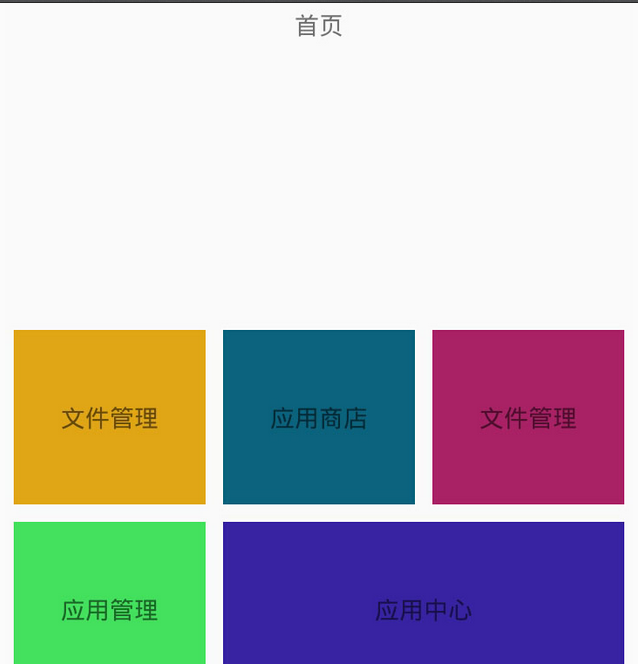
屏幕中心是一个类似Material布局,底部是一个页面切换的导航栏。底部布局通过设置android:stretchColumns=”0,1,2,3″来让四个按钮同样大小显示并填充到整个宽度,中心区域主要使用android:stretchColumns=”0,1,2″填充显示以及android:layout_span=”2″控制大内容跨列显示。
(六)GridLayout(网格布局)
作为android 4.0 后新增的一个布局,与前面介绍过的TableLayout(表格布局)其实有点大同小异;
不过新增了一些东东
①跟LinearLayout(线性布局)一样,他可以设置容器中组件的对齐方式
②容器中的组件可以跨多行也可以跨多列(相比TableLayout直接放组件,占一行相比较)
因为是android 4.0新增的,API Level 14,在这个版本以前的sdk都需要导入项目。这里不解释。
常用属性:
排列对齐:
①设置组件的排列方式: android:orientation="" vertical(竖直,默认)或者horizontal(水平)
②设置组件的对齐方式: android:layout_gravity="" center,left,right,buttom
设置布局为几行几列:
①设置有多少行: android:rowCount="4" //设置网格布局有4行
②设置有多少列: android:columnCount="4" //设置网格布局有4列
设置某个组件位于几行几列
注:都是从0开始算的哦!
①组件在第几行: android:layout_row = "1" //设置组件位于第二行
②组件在第几列: android:layout_column = "2" //设置该组件位于第三列
设置某个组件横跨几行几列:
①横跨几行: android:layout_rowSpan = "2" //纵向横跨2行
②横跨几列: android:layout_columnSpan = "3" //横向横跨2列
使用示例:
<GridLayout xmlns:android="http://schemas.android.com/apk/res/android"
xmlns:tools="http://schemas.android.com/tools"
android:id="@+id/GridLayout1"
android:layout_width="wrap_content"
android:layout_height="wrap_content"
android:columnCount="4"
android:orientation="horizontal"
android:rowCount="6" >
<TextView
android:layout_columnSpan="4"
android:layout_marginLeft="5dp"
android:layout_marginRight="5dp"
android:text="0"
android:textSize="50sp" />
<Button
android:layout_columnSpan="2"
android:layout_gravity="fill"
android:text="回退" />
<Button
android:layout_columnSpan="2"
android:layout_gravity="fill"
android:text="清空" />
<Button android:text="+" />
<Button android:text="1" />
<Button android:text="2" />
<Button android:text="3" />
<Button android:text="-" />
<Button android:text="4" />
<Button android:text="5" />
<Button android:text="6" />
<Button android:text="*" />
<Button android:text="7" />
<Button android:text="8" />
<Button android:text="9" />
<Button android:text="/" />
<Button
android:layout_width="wrap_content"
android:text="." />
<Button android:text="0" />
<Button android:text="=" />
</GridLayout>
效果图: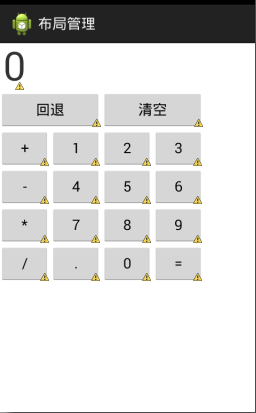
这里要说明一点:
通过android:layout_rowSpan和android:layout_columnSpan设置表明组件横越的行数与列数
再通过:android:layout_gravity = "fill" 设置表明组件填满所横越的整行或者整列
用法总结:
①GridLayout使用虚细线将布局划分为行,列和单元格,同时也支持在行,列上进行交错排列
②使用流程:
step 1:先定义组件的对其方式 android:orientation 水平或者竖直
step 2:设置组件所在的行或者列,记得是从0开始算的
step 3:设置组件横跨几行或者几列;设置完毕后,需要在设置一个填充:android:layout_gravity = "fill"
可能遇到的问题:
当读者将布局设置为GridLayout时,会出现 莫名其妙的报错,
如果代码语法逻辑没有错的话,就可能是配置文件 AndroidManifest.xml 的问题了
因为GridLayout是android 4.0 后才推出的,API Level 为 14
只需要将配置文件中的 MinSDK改成14或者以上版本 即可,保存,问题就解决了!
除上面讲过之外常用的几个布局的属性:
(1)layout_margin
用于设置控件边缘相对于父控件的边距
android:layout_marginLeft
android:layout_marginRight
android:layout_marginTop
android:layout_marginBottom
(2) layout_padding
用于设置控件内容相对于控件边缘的边距
android:layout_paddingLeft
android:layout_paddingRight
android:layout_paddingTop
android:layout_paddingBottom
(3) layout_width/height
用于设置控件的高度和宽度
wrap_content 内容包裹,表示这个控件的里面文字大小填充
fill_parent 跟随父窗口
match_parent
(4) gravity
用于设置View组件里面内容的对齐方式
top bottom left right center等
(5) android:layout_gravity
用于设置Container组件的对齐方式
android:layout_alignTop 本元素的上边缘和某元素的的上边缘对齐
android:layout_alignLeft 本元素的左边缘和某元素的的左边缘对齐
android:layout_alignBottom 本元素的下边缘和某元素的的下边缘对齐
android:layout_alignRight 本元素的右边缘和某元素的的右边缘对齐
参考转载:http://blog.csdn.net/wenzhi20102321/article/details/52677595